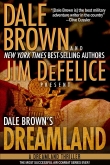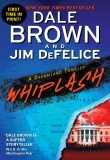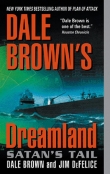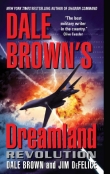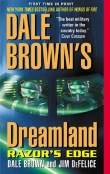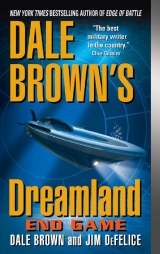
Текст книги "End Game"
Автор книги: Dale Brown
Жанр:
Боевики
сообщить о нарушении
Текущая страница: 1 (всего у книги 22 страниц)


Contents
Dreamland: Duty Roster
v
Dreamland: Weapons Systems
vii
Prelude: Dreams
1
I Test Run
7
II Impossible!
55
III Be Boarded, or Be Sunk
103
IV Monkeys in the Middle
143
V Fires of Hell
183
VI Catastrophic Events
219
VII Coming to Their Senses
253
VIII Inevitability
287
IX End Game
329
X Tai-shan
375
XI Fates Unknown
417
About the Authors
Praise
Other Books by Dale Brown and Jim DeFelice
Cover
Copyright
About the Publisher
Dreamland: Duty Roster
Lieutenant Colonel Tecumseh “Dog” Bastian Dreamland’s commander has been mellowed by the demands of his new command—but he’s still got the meanest bark in the West, and his bite is even worse.
Major Jeffrey “Zen” Stockard
A top fighter pilot until a crash at Dreamland left him a paraplegic, Zen has volunteered for a medical program that may let him use his legs again. Can Dreamland survive with a key member away?
Captain Breanna “Rap” Stockard
Zen’s wife has seen him through his injury and rehabili-tation. But can she balance her love for her husband with the demands of her career … and ambitions?
Major Mack “The Knife” Smith
Mack Smith is the best pilot in the world—and he’ll tell you so himself. But filling in for Zen on the Flighthawk program may be more than even he can handle.
Captain Danny Freah
Danny commands Whiplash—the ground attack team that works with the cutting-edge Dreamland aircraft and high-tech gear.
vi
DREAMLAND: DUTY ROSTER
Jed Barclay
The young deputy to the National Security Advisor is Dreamland’s link to the President. Barely old enough to shave, the former science whiz kid now struggles to master the intricacies of world politics.
Lieutenant Kirk “Starship” Andrews
A top Flighthawk pilot, Starship is tasked to help on the Werewolf project, flying robot helicopters that are on the cutting edge of air combat. Adjusting to the aircraft is easy, but can he live with the Navy people who are in charge of it?
Captain Harold “Storm” Gale, USN
As a young midshipman at Annapolis, Gale got Army’s goat—literally: he stole the West Point mascot just before the annual Army-Navy game. Now he’s applying the same brashness to his role as commander of the Abner Read. An accomplished sailor, the only thing he hates worse than the enemy is the Air Force.
Dreamland: Weapons Systems
Megafortress
Refurbished B-52s, complete with new skin, new wings and tail section, new engines and new sensor systems.
Besides generic versions, Dreamland flies EB-52s that carry AWACS and ground-surveillance radar, and others that carry electronic warfare and snooping equipment.
Flighthawk
Unmanned fighter aircraft typically flown from the lower weapons bay of the Megafortress. Depending on its configuration, a Megafortress will carry two or four of the robot aircraft.
Werewolf
Robot helicopters capable of being controlled from long-range through Dreamland’s dedicated satellite system. The versatile Werewolves look like miniaturized versions of the Russian Kamov Ka-50 Hokum helicopter gunship.
Piranha
A joint Navy/Air Force unmanned underwater probe, typically launched from a Megafortress on an ocean surveillance mission. Difficult to detect, the Piranha is often used to shadow enemy submarines.
viii
DREAMLAND: WEAPONS SYSTEMS
Destroyer—Littoral DD(L)
The Navy’s experimental destroyer, designed for warfare near coastlines. Considerably shorter than a conventional destroyer, the ship lies low in the water, its hull and superstructure angled to deflect radar waves.
DD(L)s carry a lethal combination of Harpoon and Standard missiles, along with torpedoes and a sophisticated canon.
Sharkboat
The modern version of the classic PT boat, designed to operate with littoral warships such as the DD(L) 01
Abner Read.
Prelude:
Dreams
Allegro, Nevada (outside Las Vegas) 5 January 1998
0310 (all times local)
HE’D HAD THE DREAM SO MANY TIMES IT WAS MORE SOMEthing he remembered than something he invented. Tiny bits of reality blurred into a jumbled progression that began and ended the same way. The beginning: running up Mead-owview Street back to his condo, pursued by the sun. This was not a normal sun—he felt its stretching fingers grope his body, burning holes in his arms, neck, and face.
The end: the black wing of a redtail hawk sailing suddenly across and through the windscreen of his aircraft.
Neither of those things had an exact parallel in real life, even when the grotesque distortions were stripped away.
Zen had gotten back to the house from his run well before the sun rose, and the robot plane that caused the air accident struck well behind the cockpit, snapping off his tailplane.
But the logic of the dream crowded out history, sometimes even when he was awake.
The middle of the dream was always different. It usually involved bits and pieces of recent events, sometimes from sorties he’d flown for Dreamland, but more often just things that happened during the day. Often his wife Breanna was in the dream, talking to him or flirting or even making love.
Today she was cooking him breakfast and complaining about the people who owned the condo downstairs. Their baby was screaming at the top of its lungs, keeping them awake.
4
DALE BROWN’S DREAMLAND
“How can you let a baby cry like that?” she asked. “Let’s have a barbecue.”
The scene changed from their kitchen to a friend’s back-yard patio. Instead of working the stove, Breanna was working the grill. When she turned away from it, Zen saw that it was piled high with wood.
“Too smoky,” he said, sitting in the cockpit of his F-15
rather than his wheelchair.
It’s too soon for the dream to end, he thought. But he coughed, and he was awake.
He still smelled smoke. Real smoke, from burning wood.
The baby was still crying.
A baby the people downstairs didn’t have.
Not a baby, the smoke alarm.
“Bree!” he yelled, jerking up.
She wasn’t beside him.
“Bree! Breanna! ”
Zen started to get out of bed. His dazed brain forgot he was paralyzed, as if that fact belonged only to the dream.
He tumbled to the floor.
Just as well—thick smoke curled above his head. He coughed, nearly choking.
Someone else coughed in the bathroom down the hall.
Breanna, his wife. “Help me!” she cried.
Flames shot up from the floor ahead, illuminating the pitch-black condo. Zen pushed forward despite the heat and flames jumping in front of his face.
Part of his mind was still back in the dream. Was he dreaming? What was dream, and what was real?
He remembered getting into the airplane on the last day he walked, whacking his shin on the side of the cockpit as he got in, thinking the bruise was going to hurt for weeks.
“Help me!” cried Breanna.
He pushed his head next to the carpet and kept going.
The bathroom door was closed.
“Open the door, open the door!” he yelled.
END GAME
5
He heard a sob, but the door remained closed. Pitching himself to the right, he reached up with his left hand and pulled down on the handle. Smoke flooded into the room. It smelled like metal being incinerated. Zen started to cough and couldn’t stop.
“Breanna!” he yelled. “Where are you? Bree? Bree?
Bree?”
He lay on his back as the flames climbed over him. He felt himself falling as the room collapsed.
ZEN WOKE WITH A SHUDDER SO VIOLENT THE BED RATTLED.
It had been a dream, a new variation of the familiar nightmare.
He reached instinctively for his wife, but she wasn’t there. He remembered now: She was in Chicago with relatives; she’d intended on flying back last night but had been snowed in, her flight canceled.
Just as well, Zen thought, squirming to get himself upright in the bed. He was still shaking from the dream. He wouldn’t have wanted her to see him like this.
But she’d seen him worse, much worse. He wished she were here, to touch.
To save.
If there had been a real fire, she would have been the one saving him, a notoriously deep sleeper.
And a cripple. A fact that didn’t vanish when he opened his eyes.
That would change. He’d walk again. He was starting his treatments today, experimental treatments, but they would give him his legs back.
Maybe that was what the dream meant, why the ending had changed. He needed his legs back to save his wife, to be with her for real.
Zen ran his fingers over his scalp and glanced at the clock at the side of the bed. It was only a few minutes past three.
But there was no way he was going back to sleep now. If 6
DALE BROWN’S DREAMLAND
Breanna were beside him, he might have managed it, might have hugged her warmth and shaken off the memory of the nightmare, but without her, the only thing to do was get out of bed and get some coffee, check the overnight sports scores and get a jump on the day.
I
Test Run
Gulf of Aden,
off the coast of Somalia
5 January 1998
1914
THE DARKNESS HAD ERASED THE LINE BETWEEN HEAVEN AND
earth, and even with his infrared glasses Captain Val Muhammad Ben Sattari had trouble finding the quartet of small aircraft as they approached the oil tanker. Built as civilian pleasure craft by a Russian company, the two-engined Sparrows were relatively quiet, their twin piston engines producing a soft hum rather than the loud drone generally associated with military aircraft. By the time the Iranian captain finally found them, the lead airplane was less than three hundred meters away, its hull planing through the water. The other three amphibious aircraft were in line behind it, ugly ducklings heading toward their rendezvous.
Four or five years ago Sattari might have looked on the tiny airplanes with amusement or even disdain. He was a fighter pilot by training and inclination, one of Iran’s best—when it still had an air force, before the black robes had run it into the ground. But with his new perspective and responsibilities, he saw the value of small, simple aircraft.
Sattari tucked the glasses into their waterproof pouch inside his tac vest and pulled the brim of his campaign cap down. Much depended on the night’s mission. It would test all of the components of the force he had built, putting them all in action to test their strengths, but also their weaknesses. For among the many hard lessons Captain Sattari 10
DALE BROWN’S DREAMLAND
had learned was that there were always weaknesses. Success required finding them before the enemy could.
Success also required the respect and unquestioning trust of the men who followed him. Both of which he would earn tonight.
Or die trying.
“We’re ready to go, Captain,” said Sergeant Ahmed Ibn, holding the captain’s AK-47 out to him. The ranking non-commissioned officer of the commando unit, Ibn’s skeptical sneer was as obvious and comfortable as his wet suit; with every glance he implied that at thirty-nine, the ex-fighter pilot was both too old and too soft to lead a team of young commandos.
Sattari checked the gun and slung it over his shoulder.
“Let’s go then.”
Aboard DD(L) 01 Abner Read,
off the coast of Somalia
1921
LIEUTENANT KIRK “STARSHIP” ANDREWS STARED AT THE
green-hued shadow near the lip of the Gulf of Aden. The shadow belonged to a boat seven miles away. It measured no more than thirty feet, with a low cabin toward the bow and a flat, probably open stern. Under other circumstances Starship might have thought it was a small fishing vessel or a pleasure boat. But no one sailed the Gulf of Aden for pleasure these days, and it was a rare fisherman who went out this late at night, let alone plied these waters near the tanker routes from the Persian Gulf.
Which meant the shadow was either a smuggler or a pirate.
Starship thought the former much more likely. He knew from experience that pirates tended to move in packs, with at least three and often as many as a dozen small boats.
“Werewolf One to Tac Command, I have the subject in sight.”
END GAME
11
“Tac. Clear to proceed.”
“Roger that.”
Starship leaned toward the screen as he pushed his hand against the Werewolf’s throttle bar. The procedure for checking out suspicious ships was straightforward: a high-speed run at low altitude, stem to stern (or vice versa), allowing the sensors aboard the Werewolf to get a good look at the target. After the first flyover the images were analyzed by specialists in Tac—officially, the Tactical Warfare Center, the nerve center of the Abner Read—who passed the information on to the tactical commander and the ship’s captain, who would then tell Starship what to do next. The Abner Read was about twenty-five miles to the southeast.
Depending on what Starship saw, the ship’s captain would decide whether it was worth bothering to pursue.
The Werewolf was a UAV, or unmanned aerial vehicle, which Starship flew from a station in a corner of the Tac Center. Combining the agility and vertical maneuvering capability of a helicopter with some of the speed of a conventional plane, it looked something like a downsized Kamov Ka-50. It had diminutive wing-mounted jet engines and a tail to go with the two counterrotating rotors at the top. Its top speed, which Starship himself had never reached, was around 400 knots, more than a hundred knots faster than most helicopters.
The Werewolf was not a Navy aircraft, nor was Starship a sailor. Both the robot and Starship had been shanghaied from Dreamland two months before, following attacks by pirates in the Gulf of Aden. Easy to fly and versatile, the Werewolf had been pressed into service as a replacement for a Navy UAV that was at least a year behind schedule.
The Dreamland craft had done such a good job that everyone from the ship’s captain to the Navy secretary sang its praises.
The same could not be said for Starship. He’d gotten this gig by being the right man in the wrong place. Already an accomplished Flighthawk pilot, he had made the mistake of 12
DALE BROWN’S DREAMLAND
cross-training in the Werewolf program so he could help out as a relief pilot during the testing program, which used mostly civilian jocks. When the Werewolves were rushed into duty with Xray Pop, Starship suddenly found himself the only military officer both qualified to teach others how to fly the craft and available for temporary duty aboard the Abner Read. Originally scheduled to last two weeks, the assignment was nearly six weeks old and showed no sign of ending soon. The Navy people rode him unmercifully, then turned around and claimed he was indispensable.
As the only Air Force officer aboard the Abner Read, he would have felt out of place in any event. But he particularly disliked the ship’s captain, whom in his more charitable moments he thought of as a blowhard. The tactical commander and ship’s executive officer, Lt. Commander Jack “Eyes” Eisenberg, was nearly as bad.
The Abner Read was a cutting edge ship, a next-generation “littoral combat vessel,” officially called a DD(L) for littoral destroyer. About the size of a corvette, it had the firepower of a destroyer but only a third of the complement. Supposedly, the officers and crew had been chosen as the most forward-thinking people in the service. Having come from Dreamland, Starship had a different perspective.
And used to the much more easygoing and fluid procedures of Dreamland, he chafed at the “fussy” discipline and strin-gent shipboard rules.
Starship had trained two sailors to fly the robot helicopter, but the ship’s captain insisted that he be at the stick during “prime time”—the hours between dusk and dawn when the pirates were most likely to strike. That meant duty from 1600 to 0700—or whatever stinking bells the Navy used to confuse landlubbers like himself. That might not have been so bad if he didn’t have to oversee the maintenance and ord-nance people assigned to the aircraft during the day. It wasn’t their fault that they were unfamiliar with the systems—but it wasn’t his fault, either, though the captain seemed to think it was.
END GAME
13
The image in the main screen in front of Starship sharpened. There were two large crates toward the stern; this was almost certainly a smuggler, bringing anything from canned goods to weapons into the northern coast of Somalia, despite UN strictures.
“Coming up on him,” Starship said. “Two crates. Uh, got, um, maybe a deckhand, only one person I see—smile for the camera, scuzzball.”
“We can do without the color commentary,” snapped Eyes.
Man, I am working with a bunch of old farts, Starship thought.
The Werewolf’s flight station, adapted from a control unit designed to be used by soldiers near the battlefield, had one large display screen and two smaller ones, all touch-screen panels. While they could be configured in a number of ways, Starship typically left the large screen as his main view screen, displaying either infrared or daylight video from the Werewolf’s nose. He usually put the system’s engineering panel in the top left-hand screen, toggling it with the weapons screen when appropriate. Below that he always put a God’s-eye-view map, generally referred to as a
“sitrep,” or situation report, map showing where he was and what was around him. The area the Werewolf flew over was rendered as a wire model, with green and red lines delineating the topography. The Werewolf was a stubby yellow double cross that, if you squinted just right, looked a little like the aircraft itself.
“Tac, we have a tanker out here,” said Starship, spotting a much larger vessel ten miles beyond the suspected smuggler. “Want me to check it out?”
“Negative, Werewolf. We have him on the sonar array.
One problem at a time.”
Starship reached for his cup of the crankcase oil the sailors claimed was coffee. As he did, the Werewolf’s flight control computer buzzed with a warning—the radar had caught sight of an aircraft approaching from the north. Before the pilot could react, the screen flashed a proximity warning—the air-
14
DALE BROWN’S DREAMLAND
plane was heading at a high rate of speed on a direct vector toward him; he had thirty seconds to evade.
Starship pushed the Werewolf stick to the left, starting an easy circle away from the airplane’s flight path. The computer had been programmed to be overanxious so that the Navy newbies he was training didn’t fly into anything; he wasn’t really in any danger of a collision. But it was curious that the other plane was flying so low. As he banked parallel to its flight path, the radar caught sight of three other airplanes, all at very low altitude and obviously following the leader.
“Tac, I have something unusual here. Four aircraft very low to the water, no running lights, no radar—can I follow them and find out what’s going on?”
“Hold tight, Werewolf.”
Old farts.
CAPTAIN HAROLD “STORM” GALE STARED AT THE HOLOgraphic display on the bridge of the Abner Read. The three-dimensional projection rose from a table behind the helmsman’s station and could be used for a variety of purposes. In this case, it was taking various sensor data to render a map of the area they were patrolling. The Abner Read, in green, sat at the right-hand corner. The smuggler the Werewolf had spotted—yellow—was toward the center, with the tanker another yellow block beyond it. There were no aircraft.
“I don’t see any airplanes,” Storm told Eyes. “You’re sure Airforce got it right?”
“He has them on his radar,” said Eyes.
Storm reached to the communication control on his belt, flipping into the Werewolf circuit. The wireless communications system allowed him to talk to all of the ship’s departments directly.
“Airforce, what are we looking at here?”
“Four unidentified aircraft, flying low and fast.”
“What types are they?”
END GAME
15
“Not sure. I haven’t seen—”
“Get closer.”
“Tac just told me—”
“Get closer!”
Storm flipped back to Eyes. “Have Airforce find out what the aircraft are.”
“What about the boat, Captain?”
“A single smuggler, no weapons visible?”
“Affirmative, Captain. He’s twenty minutes away, at our present course and speed.”
“Threat to the oil tanker?”
“Doesn’t appear so.”
“Have the Werewolf pursue the airplanes. We’ll set a course for the smuggler in the meantime.”
“Aye aye, Captain.”
THE COMPUTER ESTIMATED THE AIRCRAFT WERE MOVING AT
280 knots. The computer calculated the lead aircraft’s likely course based on the past observations—a straight line toward the eastern tip of Somalia.
“Werewolf, please close on the bandits and identify,”
said Eyes.
Gee, no kidding, thought Starship.
“Tac, be advised these aircraft are now out of my sensor range. It’d be helpful if you turned on your radar and gave me a hand.”
“Negative. We’re staying dark.”
“Do we have an Orion above?” asked Starship. As the words came out of his mouth, he realized the answer was going to be negative—the radar planes had been pulled off the gulf duty two days before, sent to Europe to help in the Kosovo mess.
“We’re on our own.”
“Yeah, roger that. OK, I’m maneuvering to follow.”
Starship arced behind the planes and revved his engines to max power.
More smugglers, probably, though the fact that there 16
DALE BROWN’S DREAMLAND
were four of them was curious. He could guess that they weren’t combatants; the planes were too small and slow.
Five minutes later, with the aircraft still out of sight, Starship asked the computer to recompute his targets’ course and probable location. The computer declared that they should be five miles dead ahead. They weren’t, and when five more minutes passed and he didn’t fly through them, Starship told Tac the obvious.
“Looks like we lost them. They probably put the pedal to the metal as soon as they picked me up on radar.”
“Repeat?”
“I believe they accelerated away. My screen is clear.”
“You’re sure they’re gone?”
“Either that or I just flew through them.”
“Stand by, Werewolf,” said Eyes, his voice dripping with venom.
“It wasn’t my fault I lost them, Commander. They had a head start. If you’d allowed me to chase them when I wanted to—”
“Stand by,” snapped the other man.
Starship continued southward; he was about sixty miles from Tohen, a tiny village on the northeastern tip of Somalia. Port Somalia—an oil terminal port built by the Indians and not yet fully operational—was another ten miles to the southeast.
“Airforce—what’s your story?” barked Storm, coming onto the communications line.
“Lost them, Captain.”
“Where are you?”
The captain knew precisely where he was. It wasn’t a question but an accusation: Why didn’t you do what I wanted you to do? Starship read off the GPS coordinates, then translated them into a rough position off Somalia.
“According to the computer, the aircraft are about a half hour from Somalia. Among the possible targets—”
“Somalia’s not my problem,” answered Storm. “Go back north and find that smuggler.”
END GAME
17
“Your call.”
“Excuse me?”
“Aye aye, Captain. Werewolf turning north.”
Las Vegas University of Medicine,
Las Vegas, Nevada
5 January 1998
0825
“YOU’RE EARLY!”
Zen shrugged as he wheeled his way across the thick rug of Dr. Michael Vasin’s office. “Yeah, figured I’d get it over with.”
“Tea?”
“Coffee if you have it, sure.”
Vasin picked up the phone on his desk and asked his assistant to bring them some. Then he got up and walked to the nearby couch, shifting around as Zen maneuvered his wheelchair catty-corner to him. Indian by birth, the doctor spoke with a pronounced accent, even though he had been in America since college.
“And everything square with work?”
“Squared away,” Zen told him. The doctor did not know the specifics of what Zen did, officially anyway. But he was friends with one of Dreamland’s most important sci-entific researchers, Dr. Martha Geraldo, who had referred Zen to him for the experimental program. So he probably knew a little, though neither man tested the specifics of that knowledge.
Vasin’s assistant came in with a tray of herbal tea, coffee, and two small cups. She was a petite, older woman, efficient at handling minutiae and thoughtful enough to ask after Zen’s wife, whom she had never met. When she left, Zen found Vasin staring out the large windows behind his desk.
The Vegas Strip lay in the distance.
“The desert is not a good place for gamblers,” said the doctor absently.
18
DALE BROWN’S DREAMLAND
Unsure how to respond, Zen said nothing.
“Jeff, I want you to understand, there are no guarantees with this. It may have absolutely no effect on you. Absolutely no effect. Even if regenerating nerve cells in the spine is possible, it might not work in your case for a million different reasons.”
“I understand.”
Vasin had already told him this many times.
“And, as we’ve discussed, there is always the possibility there will be side effects that we don’t know about,” continued the doctor.
“I read everything you gave me.”
“I’m repeating myself.” Vasin turned around, smiling self-deprecatingly. “I want you to understand it emotionally. There’s always a possibility—unforeseen—that things could be worse.”
Zen had already sat through two long lectures from Vasin and another by one of the researchers on his team outlining the potential pitfalls and dangers of the technique. He had also signed a stack of release forms.
“I’m about as aware of the dangers as I can be.”
“Yes.” Vasin rose. “Ready to get the ball rolling?”
“I thought you’d never ask.”
Air Force High Technology Advanced Weapons Center (Dreamland)
1100
LIEUTENANT COLONEL TECUMSEH “DOG” BASTIAN CHECKED
his altitude and location, then radioed to the event controller, who was sitting inside a highly modified Boeing RC-135, circling above at forty thousand feet.
“Dreamland Raptor to Event Command—Jerry, are we firing this missile today?”
“Event Command to Dreamland Raptor, we’re still hanging on Dreamland Levitow,” answered the controller, END GAME
19
referring to the EB-52 that was to fire the target missile.
“Colonel, you sound like you’re anxious to get back to your paperwork.”
Not at all, thought Dog, who greatly preferred his present office—the cockpit of Dreamland’s experimental long-range attack version of the F-22 Raptor—to the one with his cherrywood desk twenty thousand feet below. Flying cutting-edge aircraft was undoubtedly the best part of Dreamland.
The F-22 bore only a passing resemblance to the “stock”
model. Its wings had been made into long deltas; in the place of a tailfin it had a faceted quadrangle of triangles over the elongated tailpipe. The plane was twenty feet longer than the original, allowing it to accommodate an internal bomb bay that could be filled with a variety of weapons, including the one Dog was waiting to launch. The length also allowed the plane to carry considerably more fuel than a regular F-22.
“All right, Dreamland Raptor, we’re proceeding,” said the event controller. “Dreamland Levitow is on course.
They are firing test missile one… . Test missile has been launched. We are proceeding with our event.”
Test missile one was an AGM-86C whose explosive warhead had been replaced with a set of instruments and a broadcasting device. Also known as an Air Launched Cruise Missile, or ALCM, the AGM-86C was the conventional version of the frontline nuclear-tipped cruise missile developed during the 1980s and placed into storage with the re-organization of the nuclear force in the early 1990s. In this case, the missile was playing the role of a nuclear weapon.
The missile in Dog’s bomb bay was designed to render such weapons obsolete. The EEMWB—the letters stood for Enhanced ElectroMagnetic Warfare Bomb, but were generally pronounced together as “em-web”—created an electronic pulse that disrupted electric devices within a wide radius. Unlike the devices that had been used against power grids in Iraq during the 1992 Gulf War, the EEMWB used 20
DALE BROWN’S DREAMLAND
terahertz radiation—known as T-Rays or T Waves—to do its damage. Conventional electronic shielding did not protect against them, since until now there had been no need to.
Occupying the bandwidth between infrared and microwave radiation, T-Rays were potentially devastating, yet extremely difficult to control and direct. While their potential had long been recognized, their use remained only the wishful daydream of weapons scientists and armchair generals.
Until now. The Dreamland weapons people had found a way to use carefully fabricated metal shards as antennas as the pulse was generated. Computer simulations showed they could design weapons that would fry circuitry at five hundred miles.
There were two likely applications. One was as a weapon to paralyze an enemy’s electronics, a kind of super E bomb that would affect everything from power grids to wrist-watches. The other was a defense against nuclear weapons such as the one the AGM-86C simulated. The EEMWB’s pulse went through the shielding in conventional nuclear weapons that protected them from “conventional” electromagnetic shocks. By wiping out the nanoswitches and all other control gear in the weapons, the EEMWB prevented the weapon from going off.
It was possible to shield devices against the T-Rays—both Dreamland Raptor and Dreamland Levitow were proof. But the process was painstaking, especially for anything in the air.
Dog’s EEMWB had a fifty-mile radius. If successful, tests would begin in the South Pacific two weeks from now on the larger, five-hundred-mile-radius designs.
“Dreamland Raptor, prepare to fire EEMWB,” said the event controller.
“Dreamland Raptor acknowledges.” The EEMWB’s propulsion and guidance units came from AGM-86Cs, and it was fired more like a bomb than an antiair weapon, with the extra step of designating an altitude for an explosion.
END GAME
21
“Launch at will,” said the event coordinator.
“Launching.”
JAN STEWART GLANCED AT THE SCREEN AT THE LEFT SIDE OF
the control panel on her EB-52, checking the sitrep screen for her position and the location of the Dreamland landing area, now about fifteen miles away and due south. If the shielding failed when the EEMWB exploded, she would have to fly Dreamland Levitow back to base by dead reck-oning on manual control—not a prospect she relished.
Actually, Captain Stewart didn’t relish flying the Levitow, or any Megafortress, much at all. She’d been a B-1
jock and had come to Dreamland to work in a project designed to test the B-1 for conversion similar to the EB-52
Megafortress. A week after she arrived, the project’s funding was cut and she was pressed into the Megafortress program as a copilot. She outranked a lot of the other copilots and even pilots in the program, but because she was a low-timer in the aircraft, she’d been relegated to second seat by the program’s temporary head, Captain Breanna Stockard.

